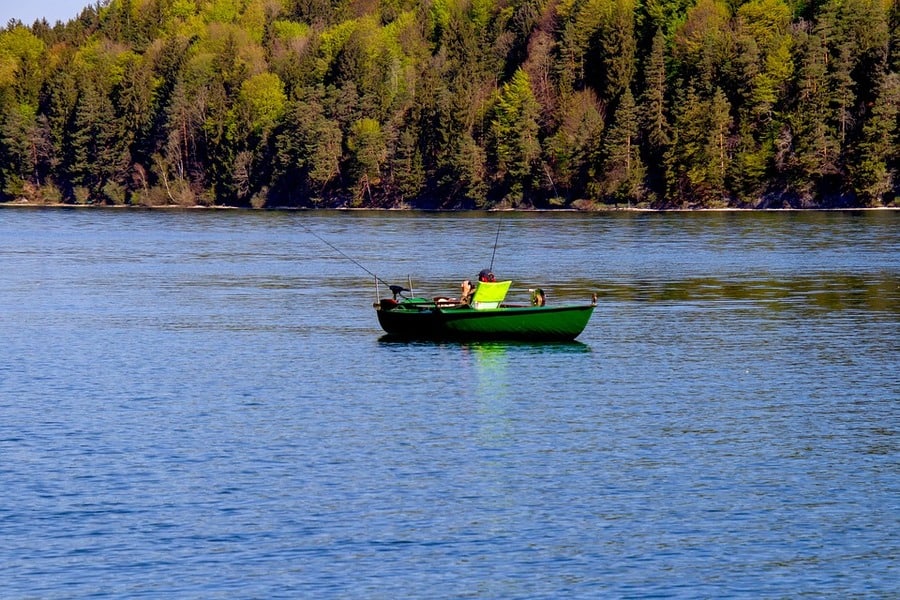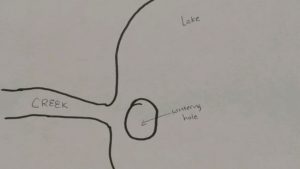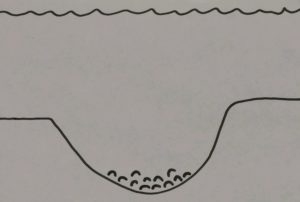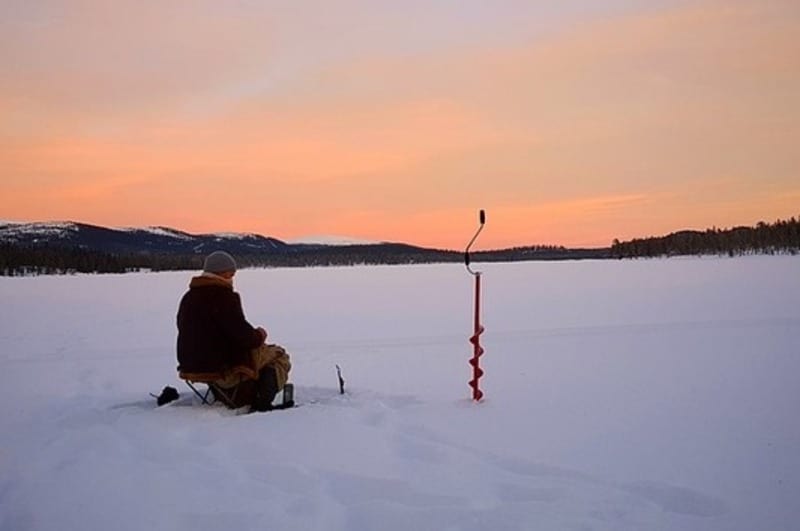Where to Fish on a Lake (A Complete Breakdown)
Leave a comment after this article and let’s talk more about lake fishing. I’d love to read your feedback.
Anytime you’re fishing a lake, you need to make quick decisions on where best to fish. This is a dilemma that is faced whether you’re fishing a new lake or one you’ve fished on your whole life.
To determine where you should fish a new lake, learn as much as you can about the lake before you arrive, assess the situation when arrive, and use seasonality and lake cues to help you find your best locations to fish. This is a very brief summary which I will now explain in much greater detail.
You can find lake fishing reports, topography and depth maps, fishing forum posts, and even online videos posted by fishermen at your destination lake.

Ask local fishermen. If you see a fisherman at the dock, ask him where the fish are biting. This is especially effective if you ask a fisherman who has already caught his limit and doesn’t need to keep secret spots a secret anymore.
One of the best places to gather intel from is your local bait shop. Not only will they have intel gathered from other fishermen about what’s working and how they’re biting, but they’ll be able to tell where the hottest parts of the lake are at the moment. Sometimes they can even tell you how to fish there.
Once you arrive at the lake, start to assess it. Look for cover like docks, trees, vegetation, and boulders. Look for points that stick out into the lake as these are often hotspots for gamefish.
Notice the topography of the land around the lake. Are the banks steep or level? Steep banks indicate a sharp dropoff and deep water whereas a shallow bank indicates shallow water that slowly gains depth.
Next, look for signs of fish and assess environmental cues. Signs of fish include shorebirds like herons as well as baitfish eating at the surface.
Environmental cues include seasonality (a big factor) and temperature. The relative air temperature compared to the time of year is a huge indicator of where fish will be on a lake.
If you are fishing on an unseasonably cool summer day, fish will be moving around off the cover whereas a day before and after, they will be huddled in the shade trying to cool off.
Table of Contents
Where to Find Fish on a Lake
To find fish, one can follow these steps: first, determine the type of fish and their preferred habitat. Then, research local fishing spots and ask seasoned anglers for advice. Utilize maps, fishing apps, or hire a fishing guide for better results. Lastly, be patient and observant while scanning the water for signs of fish activity.
Let’s look at how to find fish on a lake:
| Factor | Description | Tips for Finding Fish |
|---|---|---|
| Time of Year | Fish behavior varies by season. | – Spring: Shallow water near spawning areas. |
| – Summer: Deeper, cooler water during the day; shallower in the early morning and evening. | ||
| – Fall: Near shore as fish feed more aggressively. | ||
| – Winter: Deeper waters; slower movement. | ||
| Water Temperature | Fish are sensitive to temperature changes. | – Look for areas where there’s a sudden change in temperature, often indicative of fish activity. |
| Lake Structure | Includes points, drop-offs, ledges, and underwater structures. | – Fish often congregate around structures for shelter and food. |
| – Drop-offs and ledges are often hotspots. | ||
| Vegetation | Weeds and plants provide oxygen, shelter, and food sources. | – Edges of weed lines and submerged vegetation are good spots. |
| Water Clarity | Determines how well fish can see and be seen. | – In clear water, fish deeper; in murky water, fish shallower. |
| Baitfish Location | Predator fish follow their food. | – Look for flocks of birds diving, a sign of baitfish activity. |
| Oxygen Levels | Fish need oxygen-rich environments. | – Areas with moving water (inlets/outlets) or wind-stirred surfaces often have higher oxygen. |
| Weather Patterns | Weather affects water temperature and fish behavior. | – Barometric changes often trigger feeding activity. |
| Time of Day | Fish activity varies throughout the day. | – Early morning and late evening are often the best times. |
Choosing Where to Fish in a Lake
Pond vs. Lake: How does the Body of Water Size Affect Where to Fish on a Lake?
For the most part, the general concepts are the same in a pond as in a big lake. During the summer, fish try to find the coldest water and/or shade so focus on prominent cover like docks, vegetation, and anchored boats as well as deeper holes where the coldest water is normally found.
During the winter, focus on the deepest parts of the pond and lake. Fish are actively trying to get as far away from the cold air as possible so they will be huddled on the bottom of the deepest holes. If air temps raise any, fish will begin to emerge and start feeding near these holes.
The concepts remain the same in a pond as a lake, they are just shrunken down to a smaller scale. Determine the available fish attracting features and assess if fish should be occupying them based on the temperatures of air and water.
How Does Seasonality & Temperature Affect Where to Fish on a Lake?
Seasonality and temperature play a huge role in fish movements and location. If you understand these two factors and what they cause fish to do, you will have a great idea of where to find fish on a lake.
Seasonality
Let’s first dive into seasonality. Changing seasons cause huge changes in fish behavior and movement. I will break down all four seasons as well as how temperature changes affect fish movement. More importantly, you will find out where to fish.

1. Winter
During the winter, fish will seek out the warmest water they can find. Contrary to popular belief, fish do not stop eating in the winter.
They would starve if that was the case. Fish do slow down and their feeding activity is directly tied with relative changes in temperature.
What I mean is even if the air temperature is below freezing for a week straight, a sudden “heat wave” that brings temperatures up to near freezing will spike fish activity and feeding. Fish desperately seek to find the warmest water possible when it’s cold.

During cold spells, focus on finding the deepest holes possible that are near the mouths of streams and rivers.
These dropoffs will hold a lot of fish trying to get as far away from the cold air as possible. Fish will be more sluggish and huddle down near the bottom.
If there’s a spike in air temperature, fish will emerge from the hole and often start feeding along the walls or middle water of the hole in the upper 2/3 of the wintering hole. Refer to the 3 hand-drawn photos in this section for a clear illustration of what I mean.
It should be noted, fish will associate exclusively with deep wintering holes most of the winter under most circumstances.
Exceptions to this rule include man-made “warm water” sources like landfill treatment plant water run-off and sites where plants add their heated water to lakes.

Warm natural springs are also great places to find winter fish all season. Also, if the forecast calls for rain, fish in the rivers and streams feeding into the lake.
This water will heat up the fastest from the warmer rain and fish will move here temporarily out of their wintering holes to feed.
If you want to learn how to catch catfish during the winter, I wrote this great step-by-step “how to” guide on the topic.
Few fishermen know how to find and catch winter catfish. With this resource, you’ll be on a different playing field than other fishermen.
2. Spring
During the spring, fish emerge from their deep winter-holding areas and start heading towards shallow water. In most lakes, the first places to warm up are the shallow water areas near banks and up feeder streams and rivers. Do not fish the deep water in the spring.
Instead, focus on water less than 10 feet deep. A great rule of thumb is the earlier in the spring post-ice melt, the shallower fish will want to get. As the season moves along, warmer water can be found at progressively deeper depths.
Another huge reason why you should fish shallow during the spring is the spawn. Most fish undergo their spawn in mid-to-late spring into early summer.
Spawning patterns and behavior are very different for different species of fish but most of their spawning occurs in relatively shallow water.
Bass and panfish spawn on beds, trout and kokanee spawn in streams on redds, striped bass also spawn in streams, whereas shad and herring spawn at the surface at night in deeper water off points.
Understand your target species and where they like to spawn. This will give you a great idea of where to target your fishing efforts and catch more spring fish.
3. Summer
With the spawn over with, most fish do one of two things. They either associate tightly with prominent cover in shallow and medium water like docks, anchored boats, boulders, lily pads, and sunken timber or they head down to cover in much deeper water.
These deep water cover features can include the pillars of a concrete bridge, deep water boulders, logs, and the walls of channels and drop-offs.
Boat fishermen have the luxury of fishing both the shallow-water fish as well the ones much deeper down. Unfortunately, bank fishermen can really only target those fish associated with shallow and medium depth cover.
4. Fall
The fall is the toughest time of year in my opinion to pattern the movements of fish. The biggest thing you need to remember is fish are actively trying to pack on pounds to sustain them through the winter when their feeding actively will drop. Early fall fish tend to in shallow and medium water chasing down prey in the still relatively warm water.
As the leaves drop and the air gets colder, baitfish and zooplankton will follow the warm water into the depths. Bigger fish like bass and walleye will pursue.
This is probably the most difficult season for anglers who don’t own a boat to catch fish since fish will often move far from shore.
Don’t let this get you down, refer to my complete guide to fishing from shore. I spent days researching this topic to provide you with the ultimate resource for catching big fish from the bank without a boat.
Find areas of water near deep “wintering holes” where warmer water is still abundant. These fish will be aggressively feeding in preparation for winter.
Mid-fall is probably one of the toughest times to locate fish but once you find them, they can become easier to catch since they are so focused on feeding.
It’s no surprise that the best musky, smallmouth bass, and walleye fishing can usually occur in the fall.
Temperature

Temperature plays a huge role in both fish feeding and locations. Fish are just like any other animal on earth. They don’t like extremes and prefer a nice middle-ground.
During the summer, they are trying to cool off so you can expect to find them under shady areas or down deep in the coldest water.
During the winter, the opposite is true. In cold weather, fish try to find the warmest water they can locate so focus your search on the deep wintering holes of a lake.
These changes can also happen on a micro-level. If you are in the middle of a heatwave and you suddenly have a cloudy day, this will spike feeding activity.
Fish don’t base their movements and feeding activity on seasons alone. More importantly, they react to relative changes in water temperature.
This is one of the best at-depth digital thermometers available and can measure down to 300 feet of depth. It is a bit pricey but a great investment for all species of fish.
How to Fish in a Lake
When fishing in a lake, a few key steps can lead to success. First, research the type of fish in the lake and their feeding habits. Next, choose the right bait and equipment for the specific species. Find a suitable fishing spot with good cover.
| Fish Species | Best Techniques | Recommended Baits/Lures | Additional Tips |
|---|---|---|---|
| Bass | Casting lures around structures; Topwater fishing | Plastic worms, crankbaits, spinnerbaits | Look for structures like logs, rocks, and weed beds. |
| Trout | Trolling; Fly fishing; Spinning | Live bait (worms), spinners, flies | Fish in cooler, oxygen-rich water. |
| Catfish | Bottom fishing; Drifting | Cut bait, stink bait, chicken liver | Fish near the bottom, especially at night. |
| Walleye | Jigging; Trolling | Jigs, minnows, crankbaits | Focus on deeper water during the day. |
| Panfish (Crappie, Bluegill) | Bobber fishing; Light jigging | Small jigs, minnows, worms | Look for shallow, vegetative areas. |
| Northern Pike | Casting or trolling large lures | Spoons, large minnows, crankbaits | Focus on weed lines and structures. |
| Carp | Chumming; Bottom fishing | Corn, dough balls, boilies | Fish in warmer, shallow areas. |
| Perch | Jigging; Live bait fishing | Minnows, worms, small jigs | Often found in schools, so |
How Do You Find Fish in a Lake
Judge Topography and First Impression
If you know nothing about a lake, use every bit of information you can gather to make your assessment. Research the lake online.
Look for fishing reports, articles, and watch online fishing videos from the lake. Another great resource is other fishermen and the local bait shops.
Bait shops, in particular, as hubs of local knowledge and they often get timely information about what’s biting and where to catch them on the lake.
If the land on one side of the lake is flat, you can bet the water is shallow and gently sloping. Likewise, if the bank is steep, you can bet the water is deep with a steep decline.
If you are fishing during the summer or winter, you’ll want to focus on these deep holes. Fall and spring lend themselves more to the shallows.
Another great idea is to assess shoreline cover like weeds, trees, and rocks as well as looking for points, Fish congregate along points and under cover. This is especially true during the summer months.
Look for Signs of Fish
When you first come up to the water or are cruising around on your boat, assess your surroundings. Do you see birds like herons walking along one particular shoreline?
Do you see a lot of visible surface activity from baitfish? How about fish visibly swimming near the surface? I also, you may spot bait balls on your fishing electronics.
If you see these signs, this is a great place to start your fishing. You may not know what types of fish are in the zone, but it is safe to assume most lakes will have at least 3 the following five species: bass, catfish, yellow perch, crappie, and bluegill.
Electronics for Determine Where to Fish on a Lake
There are countless boat-mounted fishing finding electronics you could choose from. Technology has gotten so good that you see the detail on individual fish with many models.
If you are on a boat, you have the luxury of using electronics to pinpoint fish and find where you need to drop baits.
Most bank fishermen don’t have such luxury. Believe it or not, though, there are electronic fishfinders you can use from the bank.
There are a few castable fishfinders that will scan the surrounding water for depth, temperature, and the presence of fish. The Deeper Pro + (the link takes you to Amazon) is my favorite as it’s one of the very best available.
Just make sure if you use this or any other castable fishfinder, you use heavy fishing line because that’s an expensive piece of technology you really want to reel back in once you’ve seen the fish.
Patterning Fish: Warm-Water Lakes vs. Cold-Water Lakes
These terms are a bit misleading. Warm-water lakes don’t have to be in warm states and cold-water lakes don’t have to be up north.
Warm-water lakes are lakes that have prominent shoreline vegetation, have warm summer temperatures, and have an abundance of shallow-water structure to hold fish. When starting on a warm-water lake, focus around docks, vegetation, and along the bank.
Cold-water lakes are lakes that hold generally cooler water, are usually much deeper, and are defined by a general lack of shoreline vegetation.
These lakes usually are very rocky and rocks, dams, and other hard-features are the primary cover for fish.
These lakes also have very little shallow water and the shorelines drop off into deep water fast. Your best bet is to locate deep cover and features since this where many fish will congregate.
What Do You Do After You Locate Fish in a Lake
To start to catch fish after you locate them, fish fast. Choose a good “search bait” meaning a bait that you can cover a lot of ground with fast. Such baits include crankbaits, large swimbaits, and spinners.
You aren’t necessarily looking for bites, though that would be ideal. Instead, pay close attention to the water a foot or two behind your bait as you reel it in. Look for fish following your lure.
Once you spot a fish, switch to a slower presentation like a soft plastic or live bait to start catching. If you catch a fish on your “search bait”, take note of the condition of the fish. Is it healthy or looking beat up?
A fish with scars, wounds, or bruises could be an indicator there are bigger fish with teeth also in the lake.
Never stay at one spot more than 30 minutes without getting a bite. When you are trying to catch that first fish, if they aren’t biting where you are, you need to move. Keep moving until you start catching fish.
Lake Fishing Tips
- Use Seasonal Strategies: Fish behavior varies with the seasons. In spring, focus on shallow areas where fish spawn. In summer, seek deeper, cooler waters. Fall brings fish closer to shore as they feed more aggressively, and in winter, target deeper areas where fish move slowly.
- Fish Near Natural Bait Sources: Identify areas with natural food sources for fish, like insect hatches or areas with abundant smaller fish. Fishing near these food sources can increase your chances of a catch.
- Experiment with Bait and Lures: Don’t stick to just one type of bait or lure. Experiment with different options as fish might respond differently on any given day. Natural baits often work well, but artificial lures can be effective, especially if they mimic local prey.
- Keep an Eye on the Wind: Wind can affect the water’s surface and the distribution of plankton, drawing baitfish and subsequently, predator fish. Fishing downwind can sometimes lead to more successful catches.
- Utilize Technology: Modern technology like fish finders or GPS devices can be incredibly helpful in locating fish. These tools can show you depth changes, underwater structures, and even fish locations, making it easier to target specific areas.
- Understand the Lake’s Structure: Familiarize yourself with the lake’s topography, including points, drop-offs, ledges, and underwater structures. Fish often congregate around these areas.
- Know Your Target Species: Different species have different habits and preferences. Research the fish you’re targeting to understand their preferred habitats, feeding times, and bait choices.
- Pay Attention to the Weather: Fish behavior changes with weather patterns. Overcast days can lead to more active feeding, while high pressure might make fish more sluggish.
- Fish at Optimal Times: Early morning and late evening are typically the best times for fishing, as fish are more active during these cooler parts of the day.
- Practice Stealth and Silence: Fish can be startled by loud noises and sudden movements. Approach fishing spots quietly and try to minimize disturbance.
Related Questions
How to tell if a lake holds fish
There are ways to determine if a lake holds fish. Check lake reports, with local bait shops, or as around. You could also go directly to the lake and observe for birds along the shoreline, water boils caused by fish eating at the surface, and even visually see fish in the water.
How do you choose where to fish on a river?
On a river, the same general rules pertain as with lake fish expect now you have the added effect caused by the current. Fish in water breaks off the main current where water has a chance to slow down.
These are often caused by boulders, logs, or a bend in the river. Cast your bait in the slow water near where the current is rushing by.

New to fishing (Kayak), several large lakes, rocky bottoms not a lot of vegetation. Small mouth/ sunfish/ perch i have caught during the summer (70 degree water) surface to 15′ with the bottom around 30-40′. there are areas where the bottom drops off to 80-90′ and i see large schools (fishfinder) /”at that depth. i have tried a few soft baits and weights to get down to that depth but never a bite. i was told it wouldnt be SMB that deep, not sure what to use for bait . i have taken some notes from your article (awesome). any suggestions on bait to try?